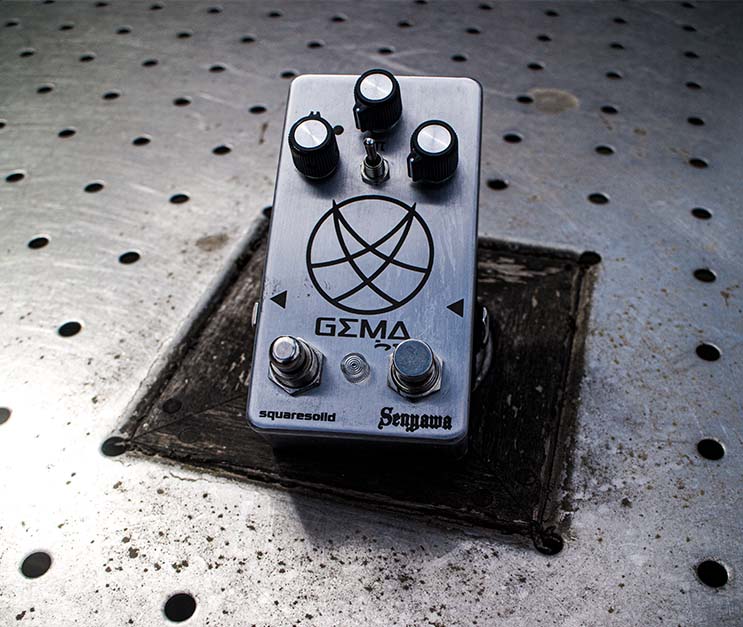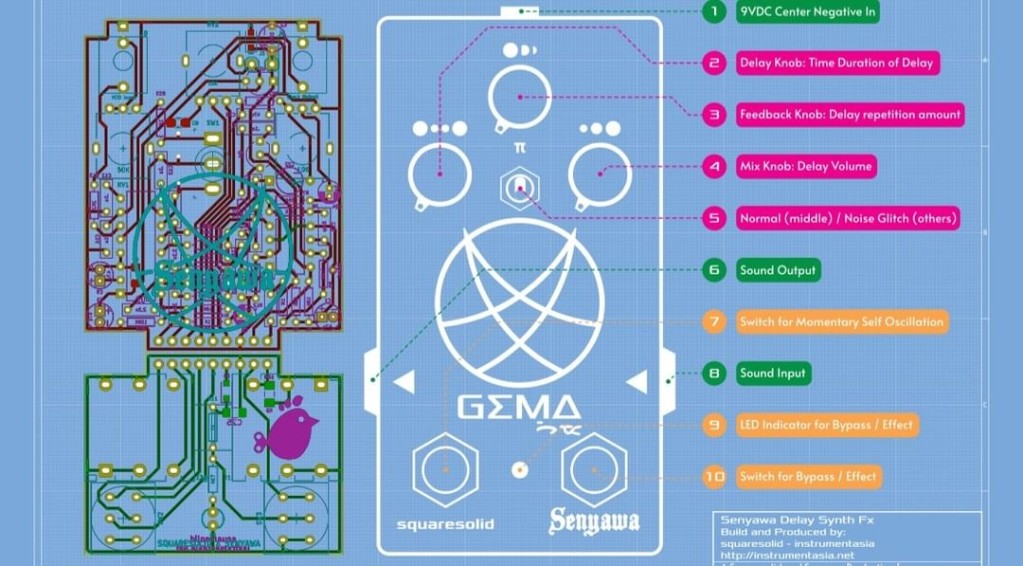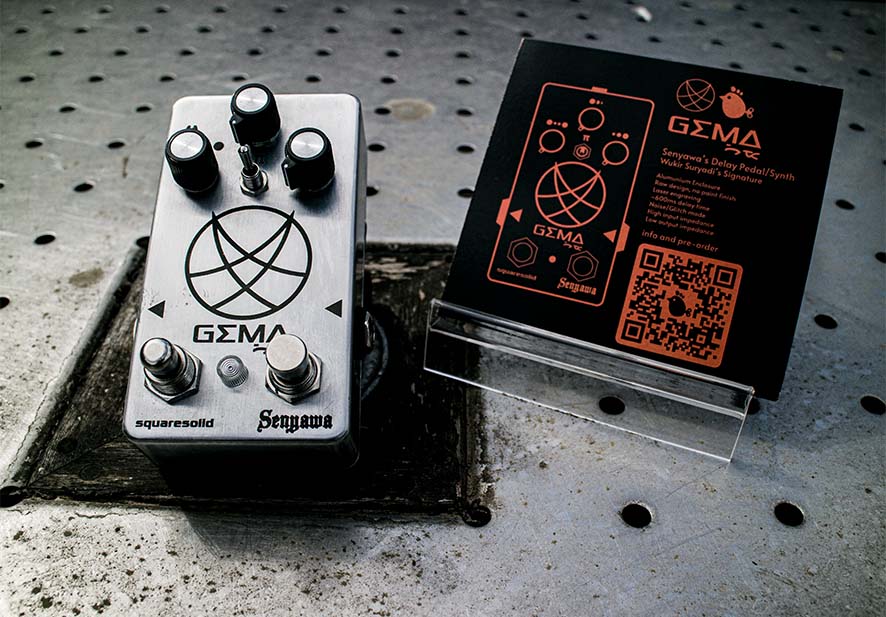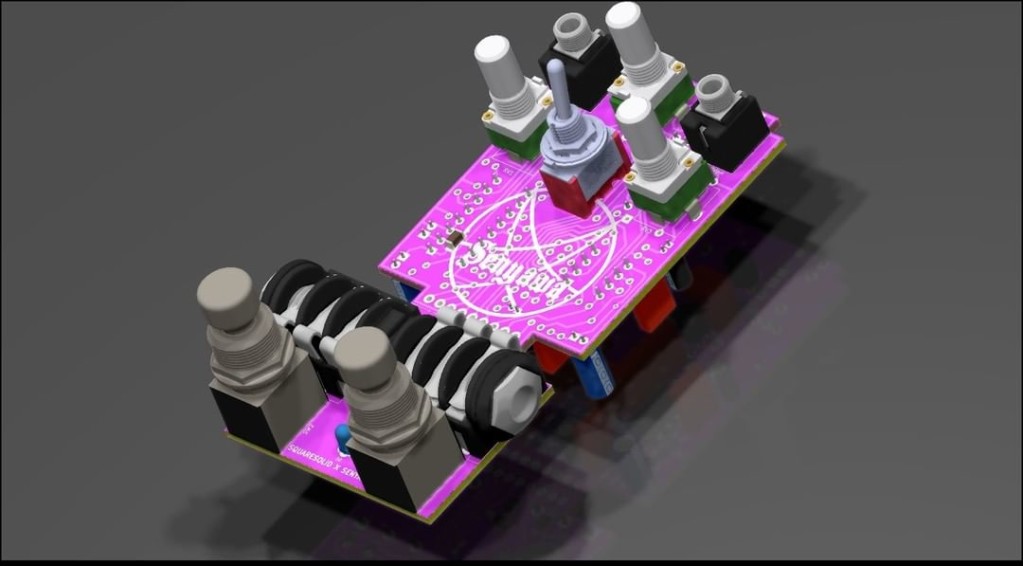From Yogyakarta, Indonesia comes a glitchy, powerful delay effect unlike any other. It’s a stompbox with an earthquake setting. And it’s a special collaboration – between Yogya’s engineer of sound and mayhem Andreas Siagian aka squaresolid and instrument builder and musician Wukir Suryadi of the band Senyawa.
The collab
Now, collaborations between artists and sound engineers come and go, but this one is pretty special. Wukir has a voracious appetite for instrument creation, repurposing objects he’ll claim right off the streets. There’s not really a line between the way he approaches instrumental technique, mods and hacks, and invention. And he inspires those ideas with anyone nearby, which I saw a few years ago as he made an impromptu appearance at our MusicMakers Hacklab here in Berlin. It’s an ideal to me for all of us – a constant flow of ideas about instruments and how to play them, hacking away.
Enter Andreas, squaresolid, who comes from an engineering background and has been a prolific inventor of machines. He’s also been a champion for creating and learning about electronics and noise both in Yogya and across southeast Asia’s increasingly wide-ranging, interconnected machine and noise scene. And – well, spurred by some unique ideas from Wukir for a different kind of stompbox, it looks like they’ve made a hell of a limited-run device.
Senyawa are also all over the place with their left-field approach to sound and culture alike, with a packed calendar in Berlin – just this week in Berlin, they have multiple appearances. What’s different about them is they’re inspiring other artists in a unique way, as with their decentralized music project. So it’s great to see a device that can be spread around, too.


The box
On its surface, GEMA is a delay pedal, 55ms – 600ms delay time, with feedback. So what makes it different:
- It’s pretty dark-sounding
- Feedback which you can crank to self-oscillation – and there’s a momentary for self-oscillation
- One glitchy mode: with π on, it “will produce a chaotic pitch repetition of the sound input combined with high hissing white noise sound.”
- One “earthquake” mode: with π off, it produces “a growling earthquake – like rumble”
And really, that’s it – but since each position of the π switch has an unusual sonic character, it’s basically never normal. Even the bypass switch isn’t a true bypass – there’s still a little bit of a tail. I misunderstood when I first looked at it, actually, thinking there was sort of a vanilla mode and a weird mode. It’s never vanilla.
Also, what makes this invention – true to Wukir’s approach – is also how you play it. Yeah, it’s pretty simple in its layout. But with that bypass-that-isn’t-a-bypass and switch and a momentary for self-oscillation, this is really intended to be played like an instrument or even imagined as a synth/sound source.
For those of us non-Indonesian speakers, the concepts are also contained in the labels. “GEMA” is Echo, “GEMPA” means earthquake — the two modes. (Germany will have a different response to “GEMA” but it might also involve some demonic rumbling sounds, so I think it still fits.)


Full specs:
- High input impedance
- Low output impedance
- Aluminium enclosure material
- Raw design, no paint finish
- Laser engraving with markings
- Noise/Glitch mode
- Size 115mm x 65mm x 55mm
- Up to ~600ms delay time
- 9V center negative adapter, circuits uses 9V and 5V regulated power
- Polarity protection
- LED in UV, signal indicator
The dials:
– OooO: is the Delay dial. It control the amount of Delay time of the pedal. The minimum delay time is 55ms and maximum delay time is 600ms.
– ODD : is the Feedback dial. It control the amount of Delay repetition of the pedal. If the dial is in maximum setting, a self oscillation will occur which is useful in GEMPA mode.
– oOO : is the Mix dial. It control the volume of Delay sound mixed with the input sound. In the minimum setting all GEMA sound is complete off except the input sound.
– ON/OFF Switch: Changing the switch Off from playing will still produce tail to pass through. This is not a true bypass pedal as Wukir’s tend to change with/without delay. Internally the circuit buffered the input and output to have high input impedance and low output impedance.
– ON: LED indicator lite on, the input sound will be GEMA. It’s not exactly a unity gain, as Wukir’s DIY instrument need a little bit of boost before it can be processed.
– OFF: LED indicator is off. INPUT = BUFFERED OUTPUT.
US$150 plus shipping, depending on where you live. Full product information and order details, in both English and Indonesian:
And here’s more on the Alkisah network, decentralized music community – really decentralized, not in some overhyped tech way (hey, who threw that tomato?):
https://www.ctm-festival.de/festival-2022/programme/features/alkisah-network
And tune in to see some of our friends explain Alkisah, live this Friday:
And there are more squaresolid things, too. For starters, you have the Chaosbyte Nebula synthesizer, now in the all-new 1.2 update. It’s a collaboration with an incredible artist:
Nekrofux is a pseudonym of Krisna Widiathama from Yogyakarta, Indonesia. Krisna is a visual artist and an illustrator. Many of his illustration has been used by RZA, Flatbush Zombie, Suicide Silence, Abiotic, Necro, along with Jogja Noise Bombing publication and merchandises. He is also a noise musician known as Sodadosa, often playing harsh noise combining analog synthesizers with guitar pedals in his sets. With Menstrual Synthdrone, they perform as duo known as Sulfur. 1 unit of Chaosbyte 1.2 Nebula will be used by Sodadosa in his future set.
And – uh, whoa:
Plus if you’re in Japan, there’s an open call for an instrument building workshop lab with Andreas plus Junichi Kanebako and Yoshihito Nakanishi – deadline this Friday.
The project has a really compelling focus, as well:
Utilizing approaches from inclusive design, this “camp” sees not only disabled people and specialists but all kinds of people with different cultures, languages, and mindsets collaborate in seeking out new ways of enjoying arts and culture. Featuring three specialists from Japan and overseas as directors, the five-day workshop program will bring together participants recruited from the general public. Through lectures and group work, the workshop will engage in collectively developing prototypes and propose new ways to enjoy music. Along with facilitating networking among participants, it aims to build a community in which those with and without disabilities share and co-develop musical instruments.
Cooperated by Ferris University, Kobe Design University
3D printer provided by APPLE TREE CO ., LTD.
More:
https://creativewell.rekibun.or.jp/en/conference/cultural-future-camp-recruitment/
And watch this space for more squaresolid action!